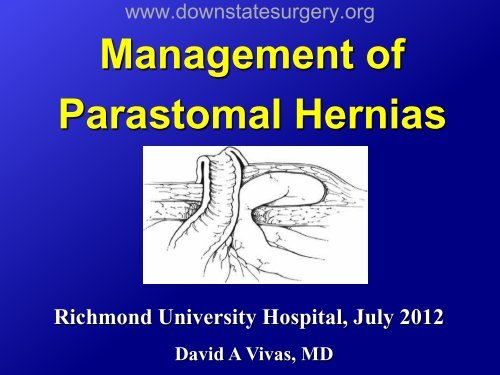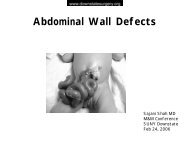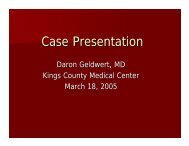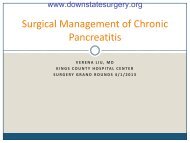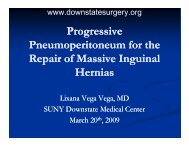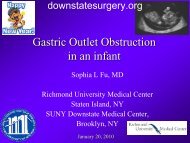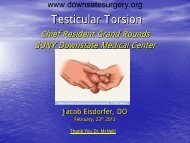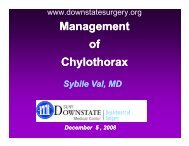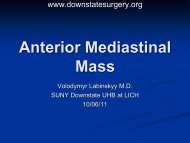Parastomal Hernia
Parastomal Hernia
Parastomal Hernia
- No tags were found...
Create successful ePaper yourself
Turn your PDF publications into a flip-book with our unique Google optimized e-Paper software.
www.downstatesurgery.orgManagement of<strong>Parastomal</strong> <strong>Hernia</strong>sRichmond University Hospital, July 2012David A Vivas, MD
HPIwww.downstatesurgery.orgCase Presentation• 85 y/o male s/p APR in 1978 for rectal cancer,no chemo/RT• S/p TURP, prostatectomy• HTN, hypercholesterolemia, gout• 10/2010 patient presented with large abscessadjacent to ostomy site with fecal drainage andcommunication with the colostomy
www.downstatesurgery.orgCase Presentation• Patient underwent incision and drainage ofabscess, repair of a colonic perforation above thelevel of the fascia and construction of divertingtransverse loop colostomy•Postoperatively patient had NSTEMI andunderwent cardiac catheterization andsubsequent CABG and aortic valve replacement
www.downstatesurgery.orgCase Presentation• In 09/2011 patient presented with enlarging,non reducible LLQ parastomal hernia• Patient underwent resection of LLQ endsigmoid colostomy with resection of descendingcolon and primary repair of LLQ parastomalhernia.
www.downstatesurgery.orgCase Presentation• PE demonstrated a healthy loop colostomy,with a reducible parastomal hernia locatedinferior and lateral to the stoma with a fasciadefect approximately 8 cm in diameter
www.downstatesurgery.orgCase Presentation• The hernia sac was identified and dissected awayfrom surrounding tissues down to the level of thefascia• The sac was opened and its content (omentum)reduced• The superior aspect of the defect was occupied bythe ostomy.
www.downstatesurgery.orgCase Presentation• The defect measured approximately 8 to 10 cm• The hernia defect was reapproximated primarily withinterrupted #1 Prolene, extending both form the lateraland medial aspect of the hernia defect
www.downstatesurgery.org
www.downstatesurgery.orgCase Presentation• There was no constriction of the stoma at thelevel of the fascia•The wound was irrigated and a 10 mmJackson-Pratt drain was placed• On POD#1 patient was tolerating a diet, witha healthy looking stoma and normal bowelfunction and was discharged home
www.downstatesurgery.orgCase PresentationQuestions?
www.downstatesurgery.orgStomas• Approximately 120,000 new stomas will becreated in the United States each year• It is estimated that the number of ostomateswill continue to increase by 3% annually
www.downstatesurgery.orgStomas• Surgically created opening between ahollow organ and the body surface orbetween any two hollow organs• It is further named by the organ involved
www.downstatesurgery.orgStomas• An ostomy is created:• When an anastomosis is not possible• When there is nothing dis-tally to attach to• For proximal diversion• The majority of ostomies are created as atemporary measure
www.downstatesurgery.orgStomas• Ostomies may be temporary or permanent• Temporary stomas divert the fecal streamaway from an area of concern• High-risk anastomosis• Located in a radiated field• Low in the rectum• After an injury
www.downstatesurgery.orgIndications for Stoma Creation• Cancer• Diverticular disease• IBD• Radiation enteritis• Complex fistulas• Trauma• Obstruction• Perforation• Motility andfunctional disorders• Infections (necrotizingfasciitis, Fournier’s)• Congenital disorders
www.downstatesurgery.orgType of Stomas• By anatomical location• Ileostomy• Colostomy
www.downstatesurgery.orgType of StomasIleostomy:• Opening constructed between the smallintestine and the abdominal wall, usually byusing distal ileum, but sometimes moreproximal small intestine
www.downstatesurgery.orgType of Stomas• Types of ileostomies include:• End (Brook) ileostomy (most common)• Loop ileostomy• Loop-end ileostomy• Continent ileostomy (Kock)• Urinary conduit
www.downstatesurgery.org
www.downstatesurgery.orgType of StomasColostomy:• Is an opening of the large intestine with nosphincteric control• It is categorized by the part of the colonused in its construction• End-sigmoid, end-descending,transverse colostomy, cecostomy
www.downstatesurgery.orgType of StomasFunctions of Colostomy:• To provide decompression of the large intestine:• “Blow-hole" decompressing stoma• Tube type of cecostomy• Loop-transverse colostomy• To provide diversion of the feces• Loop colostomy• End colostomy
www.downstatesurgery.org
www.downstatesurgery.org
www.downstatesurgery.org
www.downstatesurgery.orgStoma-related Complications• The rate of stoma complications in theliterature varies quite widely, rangingfrom 10 to 70%• Virtually all ostomates will have at leasttransient episodes of minor peristomalirritation
www.downstatesurgery.orgStoma-related ComplicationsMetabolic (Medical intervention)- Peristomal skin irritation- Leakage- High output- Ischemia- Dehydration, nephrolithiasis,cholelithiasis, bleeding
www.downstatesurgery.orgStoma-related ComplicationsStructural etiology (Surgical intervention)• Early complicationsNecro-sisRetractionSkin irritationSmall bowel obstructionSurgical wound infection, sepsis
www.downstatesurgery.orgStoma-related ComplicationsStructural etiology (Surgical intervention)• Late complicationsProlapseSkin irritationFecal fistula<strong>Parastomal</strong> hernia
www.downstatesurgery.org
www.downstatesurgery.org<strong>Parastomal</strong> <strong>Hernia</strong> (PSH)• Type of incisional hernia that occurs at thesite of the stoma or immediately adjacentto the stoma• It forms when the trephine is continuallystretched by the tangential forces appliedalong the circumference of the abdominalwall opening
www.downstatesurgery.org<strong>Parastomal</strong> <strong>Hernia</strong> (PSH)Incidence:• PSH is the most frequent structuralcomplication following the constructionof a colostomy or an ileostomy• The reported incidence varies widely:• Lack of a standard definition• Type of ostomy constructed• Variability in the duration of follow-up
www.downstatesurgery.org<strong>Parastomal</strong> <strong>Hernia</strong> (PSH)Incidence:• PSH occurs:• 1.8 to 28.3 percent of patients with endileostomies• 0 to 6.2 percent with loop ileostomies• 4.0 to 48.1 percent with end colostomies• 0 to 30.8 percent with loop colostomies
www.downstatesurgery.org<strong>Parastomal</strong> <strong>Hernia</strong> (PSH)Incidence:• Most parastomal hernias occur withinthe first two years from construction
www.downstatesurgery.org<strong>Parastomal</strong> <strong>Hernia</strong> (PSH)Classification:• Subcutaneous: <strong>Hernia</strong>tion in subcutaneous fat• Interstitial: <strong>Hernia</strong>tion into the intermuscular planes• Perstomal: Loops of bowel and/or omentum enter thehernia space produced between the layers of theprolapsed bowel• Intrastomal: <strong>Hernia</strong>tion extrudes from the abdomenalongside the bowel for the stoma
www.downstatesurgery.org<strong>Parastomal</strong> <strong>Hernia</strong> (PSH)
www.downstatesurgery.org<strong>Parastomal</strong> <strong>Hernia</strong> (PSH)Risk FactorsPatient variables:• Smoking status• Malnutrition• Age• Waist circumference (>100 cm)
www.downstatesurgery.org<strong>Parastomal</strong> <strong>Hernia</strong> (PSH)Risk FactorsDisease processes:• Obesity (BMI >30 kg/m2)• COPD• Diabetes• Ulcerative colitis• Raised intra-abdominal pressure• Postop sepsis• Perioperative steroid• Malignancy
www.downstatesurgery.org<strong>Parastomal</strong> <strong>Hernia</strong> (PSH)Risk FactorsTechnical factors:• Emergency procedures• When preoperative siting is not possible• Siting of the stoma outside of the rectus muscle• Aperture size
www.downstatesurgery.org<strong>Parastomal</strong> <strong>Hernia</strong> (PSH)Clinical Manifestations:• Most patients with a PSH are asymptomatic• Typically present with a bulge at the site of oradjacent to the intestinal stoma (+/- pain)• Mild abdominal discomfort, back pain,intermittent cramping• Distention, nausea, vomiting, diarrhea,constipation• Reducible hernia
www.downstatesurgery.org<strong>Parastomal</strong> <strong>Hernia</strong> (PSH)In complicated cases:• Severe abdominal pain, nausea, vomiting, andan unreducible hernia
www.downstatesurgery.org<strong>Parastomal</strong> <strong>Hernia</strong> (PSH)Diagnosis:• Based on characteristic findings on physicalexamination• Patient is examined in the standing position andasked to perform the Valsalva maneuver• Diagnostic imaging to evaluate subclinical PSHin patients with a negative physical examinationis unnecessary
www.downstatesurgery.org<strong>Parastomal</strong> <strong>Hernia</strong> (PSH)Indications for Surgical Intervention:• Low rate of life threatening complications• Emergent surgical repair is indicated in patientswith a high grade obstruction resulting fromstrangulation or an unreducible hernia
www.downstatesurgery.org<strong>Parastomal</strong> <strong>Hernia</strong> (PSH)Indications for Elective Surgical Intervention• Increasing PSH size• Peristomal skin breakdown• Intermittent bowel obstructions• Stoma appliance dysfunction and leakage• Chronic back and/or abdominal pain• Psychological distress• Stoma dysfunction
www.downstatesurgery.org<strong>Parastomal</strong> <strong>Hernia</strong> (PSH)Non-surgical Management:• Surgical repair avoided in mild/asymptomaticpatients• Most patients can be managed with an ostomyhernia belt• Education about signs and symptoms ofobstruction, strangulation, and infarction ofbowel
www.downstatesurgery.org<strong>Parastomal</strong> <strong>Hernia</strong> (PSH)Surgical Repair• Multiple approaches have been reported• No ideal repair• All approaches are associated with varyingrecurrence rates
www.downstatesurgery.org<strong>Parastomal</strong> <strong>Hernia</strong> (PSH)Surgical Repair:• Relocation of the stoma• Direct repair of the fascialdefect with or withoutprosthetic mesh• Repair using a prosthetic mesh• Laparoscopic repair
www.downstatesurgery.org<strong>Parastomal</strong> <strong>Hernia</strong> (PSH)Direct repair of the fascial defect• Local aponeurotic repair obviates the need forlaparotomy and stoma relocation• Direct repair with of fascial defect with suturealone is associated with a recurrence rate in theliterature of 50-100%
www.downstatesurgery.org
www.downstatesurgery.org<strong>Parastomal</strong> <strong>Hernia</strong> (PSH)Relocation of the stoma• Requires a formal celiotomy• The risk of a recurrent parastomal hernia at thenew site is at least as high as after the primaryenterostomy• If the stoma is relocated a second time,recurrence rates are further increased
www.downstatesurgery.org<strong>Parastomal</strong> <strong>Hernia</strong> (PSH)Repair using prosthetic mesh• Most common method of PSH repair• The overall success rate is relativelyhigh compared with repair withoutmesh
www.downstatesurgery.org<strong>Parastomal</strong> <strong>Hernia</strong> (PSH)Repair using prosthetic mesh• Reports are nonrandomized• Small patient numbers• Different techniques• Variable follow-up• Complications include contamination of themesh and fistula formation, while very rare, canbe devastating
www.downstatesurgery.org<strong>Parastomal</strong> <strong>Hernia</strong> (PSH)• Direct fascial repair with mesh• An incision is made in the abdominal wallaway from the stoma• Subcutaneous dissection along the rectus andoblique fascia is performed circumferentiallyaround the stoma
www.downstatesurgery.org<strong>Parastomal</strong> <strong>Hernia</strong> (PSH)• Direct fascial repair with mesh• The content of the hernia is reduced into theabdomen and abdominal wall defect is closedusing a tension free mesh repair• Small, non-randomized series report lowcomplication rates and recurrence rates of 0to 20 percent
www.downstatesurgery.org<strong>Parastomal</strong> <strong>Hernia</strong> (PSH)• Advantages of direct fascial repair with mesh• Avoids the need for a formal laparotomy• Does not require relocation of the stoma• Disadvantages include:• Undermining the skin around the stoma withrisk of ischemic injury to the skin• The risk of infection contaminating the meshwhich is higher than intraperitonealplacement of mesh
www.downstatesurgery.org
www.downstatesurgery.org<strong>Parastomal</strong> <strong>Hernia</strong> (PSH)Intraabdominal repair with mesh• Strategy based on the similarities betweenincisional hernia and parastomal hernia• The mesh can be placed in an onlay, an inlay, asublay, or an intraperitoneal onlay position(IPOM)
www.downstatesurgery.org<strong>Parastomal</strong> <strong>Hernia</strong> (PSH)Intraabdominal repair with mesh• Onlay technique: mesh is placed on the anteriorAponeurosis• Sublay technique: mesh is placed dorsal to therectus muscle, anterior to the posterior rectussheath
www.downstatesurgery.org<strong>Parastomal</strong> <strong>Hernia</strong> (PSH)Intraabdominal repair with mesh• Intraperitoneal onlay position (IPOM)technique: mesh is placed intra-abdominally onthe peritoneum• Inlay technique: mesh is cut to the size of theabdominal wall defect and sutured to woundedges
www.downstatesurgery.org<strong>Parastomal</strong> <strong>Hernia</strong> (PSH)
www.downstatesurgery.org<strong>Parastomal</strong> <strong>Hernia</strong> (PSH)Intraabdominal repair with meshCommon aspect of all of the approaches• Reduction of the hernia contents into theabdominal cavity• Closure of the defect by securing a piece ofmesh under the defect with wide overlap• The bowel forming the ostomy is eitherbrought out directly through a defect in themesh, the "key hole" technique, or around themesh
www.downstatesurgery.orgIntraabdominal Mesh Repair of<strong>Parastomal</strong> <strong>Hernia</strong>
www.downstatesurgery.org<strong>Parastomal</strong> <strong>Hernia</strong> (PSH)Laparoscopy repair of PSH• Evolving technique• Avoids second laparotomies and operationsin contaminated fields reducing the risk ofmesh infection• Laparoscopic PSH repairs can generally bedivided into two groups• “Keyhole-techniques• "Sugarbaker techniques”
www.downstatesurgery.orgLaparoscopic mesh repair of<strong>Parastomal</strong> <strong>Hernia</strong>
www.downstatesurgery.org
www.downstatesurgery.org
www.downstatesurgery.org<strong>Parastomal</strong> <strong>Hernia</strong> (PSH)• There are several types of meshes available• They are classified into 2 broad categories• Synthetic• Polypropylene, PTFE• Biological• Human dermis (Alloderm), Porcine dermis (Permacol,Strattice)
www.downstatesurgery.orgSurgical Technique for<strong>Parastomal</strong> <strong>Hernia</strong> RepairA Systematic Review of theLiteratureHansson, B. et alAnn Surg 2012;255:685-695
www.downstatesurgery.orgObjective• To evaluate and compare the safety andeffectiveness of the surgical techniquesavailable for parastomal hernia repair
www.downstatesurgery.orgMethods• Systematic review• Subgroups formed for each surgicaltechnique• Primary outcome: recurrence after at leastone year followup• Secondary outcomes: mortality andmorbidity
www.downstatesurgery.orgResults• 36 studies included• Suture repair resulted in significantlyincreased recurrence rate when comparedwith mesh repair (aprox 70%)• Recurrence rates for mesh repair rangedfrom 6.9-17% and did not differsignificantly
www.downstatesurgery.orgResults• In the laparoscopic repair group:– The Sugarbaker technique had less recurrencesthan the keyhole technique (OR 2.3, 95% CI1.2-4.6; p=0.016)• Morbidity did not differ between thetechniques• Mesh infection rate• Overall low: 3% (95% CI 2)• Comparable for each type of mesh repair
www.downstatesurgery.orgConclusions• Suture repair of parastomal hernia should beabandoned because of increased recurrence rates• The use of mesh in parastomal hernia repairsignificantly reduces recurrence rates and is safewith a low overall rate of mesh infection• In laparoscopic repair, the Sugarbaker technique issuperior over the keyhole technique showingfewer recurrences
www.downstatesurgery.org<strong>Parastomal</strong> <strong>Hernia</strong>Prevention• Attention to proper surgical technique:• Well vascularized• Non-traumatized• Tension free anastomosis between the skin andintestine• A stoma should never be brought out through thelaparotomy wound
www.downstatesurgery.org<strong>Parastomal</strong> <strong>Hernia</strong>Prevention• The stoma should be brought through the rectusabdominis muscle• Higher rates of hernia formation occur when thestoma is brought lateral to the rectus
www.downstatesurgery.org<strong>Parastomal</strong> <strong>Hernia</strong>Prevention• The opening should be made large enough to allowthe bowel to pass• Diameter of the opening should be around 2.5 cm,or two to three of the surgeon’s fingers• Larger openings in the abdominal wall, may beassociated with an increased risk of parastomalherniation
www.downstatesurgery.org<strong>Parastomal</strong> <strong>Hernia</strong> (PSH)• There is no need to fixate the mesentery or suturethe bowel to the aponeurosis as this has not reducedthe rate of herniation• Although laparoscopic techniques are commonlyused and safe, they have not proven effective inhernia prevention
www.downstatesurgery.org<strong>Parastomal</strong> <strong>Hernia</strong> (PSH)• The only method that has reduced the rate ofparastomal hernia in a randomized trial is the use ofa prophylactic mesh• Randomized trials (3), prospective observationalstudies (5), and descriptive techniques promote abenefit for prophylactic mesh placement
www.downstatesurgery.org<strong>Parastomal</strong> <strong>Hernia</strong> (PSH)• At the time of initial stoma creation, onlayor sublay placement of prophylactic mesh• In studies available:• Followup periods ranged from 2 to 68 months• Infections and other long-term complications rarelyreported• Recurrent hernia after prophylactic mesh placementwas less than 15% for all studies included
www.downstatesurgery.org<strong>Parastomal</strong> <strong>Hernia</strong> (PSH)• Randomized, Controlled, Prospective Trialof the Use of a Mesh to Prevent <strong>Parastomal</strong><strong>Hernia</strong>• Serra-Arucil X et al.• Ann Surg 2009;249:583-587
www.downstatesurgery.orgRandomized, Controlled,Prospective Trial of the Use of aMesh to Prevent <strong>Parastomal</strong> <strong>Hernia</strong>• Objective:– To reduce the incidence of parastomal herniaby implanting a lightweight mesh in the sublaypositions
www.downstatesurgery.orgRandomized, Controlled, Prospective Trial ofthe Use of a Mesh to Prevent <strong>Parastomal</strong><strong>Hernia</strong>• Randomized controlled prospective trial• Patients scheduled for permanent end colostomy to treat cancerof lower third of rectum• Light weight mesh (Ultrapro) inserted in sublay position in studygroup (above the peritoneum and the posterior rectus sheath• Simple randomization• Clinical and radiologic followup (abdominal CT) at 1 month andevery 6 months after surgery• Clinician and radiologist were blind to the aims of the study
www.downstatesurgery.orgRandomized, Controlled, Prospective Trial ofthe Use of a Mesh to Prevent <strong>Parastomal</strong><strong>Hernia</strong>• Results:– Homogeneous groups (clinical anddemographics)– Surgical time and postoperative morbiditysimilar in both groups– Zero mortality– No mesh intolerance
Randomized, Controlled, ProspectiveTrial of the Use of a Mesh to Prevent<strong>Parastomal</strong> <strong>Hernia</strong>• Clinical follow-up:– Median 29 months (13-49)– 11/27 (40.7%) hernias in control group– 4/27 (14.8%) in study group– p=0.03• Abdominal CT:– 14/27 (44.4%) hernias in control group– 6/27 (22.2%) in study group– p=0.08www.downstatesurgery.org
www.downstatesurgery.orgRandomized, Controlled, Prospective Trialof the Use of a Mesh to Prevent <strong>Parastomal</strong><strong>Hernia</strong>• Conclusions:– <strong>Parastomal</strong> placement of a mesh reduces theappearances of parastomal hernia– The technique is safe , well tolerated and doesnot increase morbidity rates
www.downstatesurgery.orgReferences1. Israelson LA. <strong>Parastomal</strong> <strong>Hernia</strong>s. SurgClin N Am (2008); 88:113-1252. Serra-Arucil X et al. Randomized, Controlled, Prospective Trial ofthe Use of a Mesh to Prevent <strong>Parastomal</strong> <strong>Hernia</strong>. Ann Surg2009;249:583-5873. Hansson, B. et al. Surgical Technique for <strong>Parastomal</strong> <strong>Hernia</strong> RepairA Systematic Review of the Literature. Ann Surg 2012;255:685-6954. Dykes S. Ostomies and Stomal Therapy. Core Subjects 2010. Fromhttp://www.fascrs.org
www.downstatesurgery.orgQuestion #1• Based on current evidence, placement ofmesh to prevent hernia occurrence isassociated with:a. Decreased hernia ratesb. No increase in morbidityc. Decreased rate of surgical intervention inorder to repair a herniad. All of the above
www.downstatesurgery.orgQuestion #1• Based on current evidence, placement ofmesh to prevent hernia occurrence isassociated with:a. Decreased hernia ratesb. No increase in morbidityc. Decreased rate of surgical intervention inorder to repair a herniad. All of the above
www.downstatesurgery.orgQuestion #2• Which of the following aspects ofmanagement has been consistently shown todiminish the risk for stoma-relatedcomplications?a. Preoperative visit by an enterostomal therapistb. Placement of the stoma through the rectusmusclec. Closure of the lateral gutterd. Suture fixation of the stoma to the fasciae. Use of absorbable sutures to secure the stoma
www.downstatesurgery.orgQuestion #2• Which of the following aspects ofmanagement has been consistently shown todiminish the risk for stoma-relatedcomplications?a. Preoperative visit by an enterostomal therapistb. Placement of the stoma through the rectusmusclec. Closure of the lateral gutterd. Suture fixation of the stoma to the fasciae. Use of absorbable sutures to secure the stoma
www.downstatesurgery.orgPreoperative counseling and markingby an enterostomal therapist improvespostoperative quality of life
www.downstatesurgery.orgQuestion #3• Which of the following factors is mostclosely associated with development ofparastomal hernia?a. Obesityb. Corticosteroid usec. Obstructive pulmonary diseased. Ileal stomae. Long term survival
www.downstatesurgery.orgQuestion #3• Which of the following factors is mostclosely associated with development ofparastomal hernia?a. Obesityb. Corticosteroid usec. Obstructive pulmonary diseased. Ileal stomae. Long term survival
www.downstatesurgery.orgDespite a long list of suggestingpredisposing factors for parastomalhernia formation (including obesity,corticosteroid use and obstructivepulmonary disease), few have beenstudied and found to be trulyinstrumental in increasing the risk.One widely noted finding is thatthe likelihood of parastomalhernia development increases overtime.
www.downstatesurgery.orgThank you!


